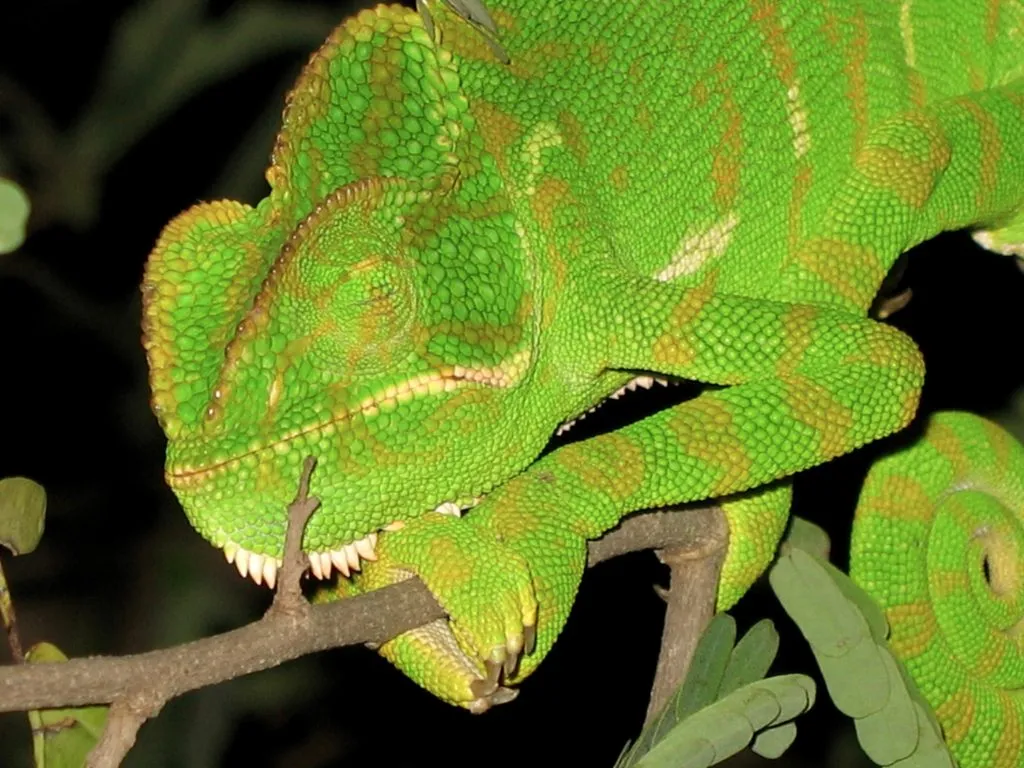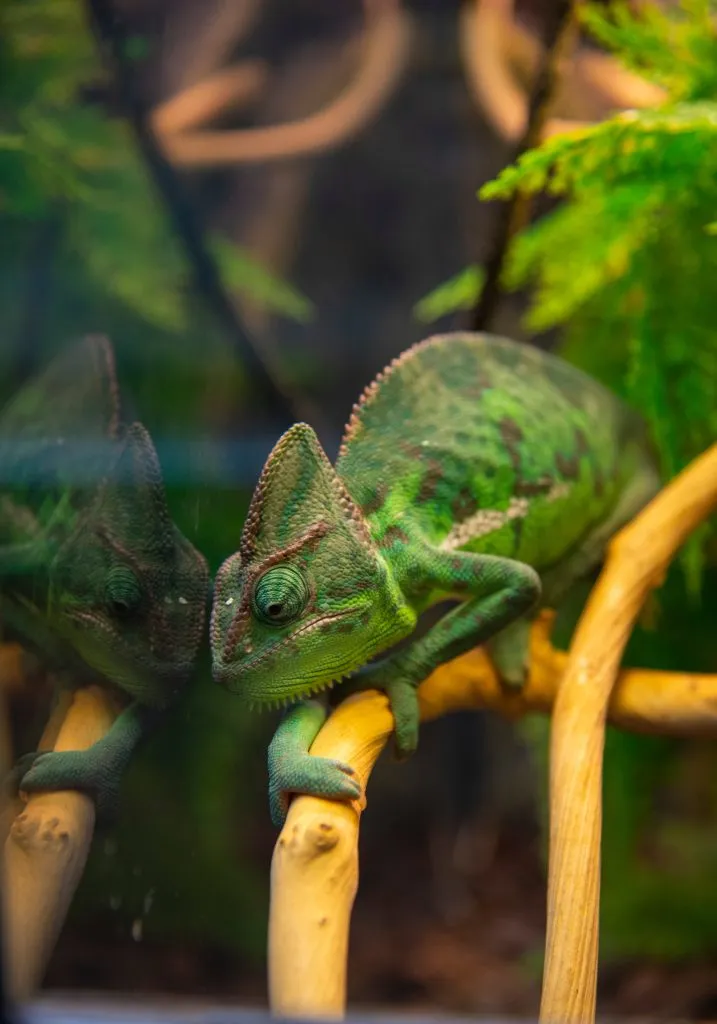
You may notice that your chameleon is waving at you whenever you pass by its enclosure, however cute this may be, your chameleon may actually be scratching the glass of its cage. Why do chameleons scratch the glass? What can you do to stop this behavior?
Chameleons scratch the glass of their enclosures when the temperature or humidity in the enclosure is wrong. They also do this when the enclosure is dirty or too small for them. The enclosure may also lack hiding or climbing surfaces. Further, other chameleons may be within their sight.
Typically, it means that something is stressing your chameleon when it starts scratching the glass of the enclosure. The scratching is its failed attempt to escape its current living conditions. Keep on reading to find out what you can do to stop this behavior.
Table of Contents
Glass Scratching Of Chameleons And Stress
It is not normal behavior for chameleons to scratch the glass or screen surfaces of their enclosure. When this happens, it is a huge indication that your chameleon is stressed.
You should immediately find the source of their stress as prolonged stress in chameleons can hinder their growth, affect their reproductive system, and also weaken their immune system. This can result in illnesses or even death.

Chameleons communicate using body language and the shift in their colors. When the stressor within their environment has been present for a long time, you will notice that your chameleon will turn into a darker color while it is scratching the glass.
At the same time, your chameleon may also nap in an exposed part of the enclosure while its tail is curled. Keep in mind, chameleons do not take naps during the day, so this is a huge sign that it is already under immense stress.
Reasons Why Your Chameleon Is Scratching At The Glass
Here are the reasons why the glass-scratching behavior is happening and the things that you can do to stop this behavior.
1. The Temperature Or Humidity Of The Enclosure Is Wrong
Your chameleon will scratch the glass or screen of its enclosure in an attempt to escape when it cannot properly thermoregulate or breathe.
The temperature of the enclosure is key to their thermoregulation and too much humidity can affect the air quality.
Depending on the type of chameleon you have, the basking temperature should be between 85-95 F. As for the ambient temperature, it should be between 75-85 F. The humidity inside the enclosure should be between 65-80%
What You Can Do
Check the basking and ambient temperature by using an infrared thermometer (like this one). If the temperature is running low, it is time to change the bulb of your heat lamp.
You should also check if your designated basking spot was moved lower compared to your initial setup.
You can use this hygrometer to check the moisture levels in the enclosure. If the humidity is below the required level, mist the enclosure.
If it is too humid, skip the next misting schedule, and check the hygrometer again before you resume misting.
Tip: Is your chameleon’s mouth open all the time? Read our article on that here!
2. The Cage Is Too Small For Your Chameleon

Chameleons love to explore their surroundings and need a tall area to do climbing behavior. If the enclosure is too small, they feel trapped.
Much like a human being who is trapped in an elevator for 24 hours, we would also try to claw our way out.
Usually, this is the reason behind the glass-scratching behavior when it is paired with the pacing of your chameleon to another area of the enclosure to resume scratching another part of the glass again.
What You Can Do
In choosing an enclosure for a chameleon, you should get a tall and vertical enclosure. If you have a baby chameleon, a 16″x16″x30″ enclosure size will suffice. For adults, they will be content in a 24″x24″x48″ enclosure.
If you happen to have a horizontal enclosure, it should still have enough height to accommodate climbing branches and vines for your chameleon to have at least a space to climb.
However, this should not be the permanent solution as usually, chameleons will stay at the high points of the enclosure which may be too near to the heat lamp, and this will lead to burns.
Therefore, you should really get the right enclosure size.
3. The Enclosure Is Dirty
Water tends to pool at the bottom of the enclosure due to constant misting. The water at the bottom may pool easily, especially when you have an automatic misting system or a dripper, and the enclosure does not have drainage.
The pooled water paired with the constant heat and droppings of your chameleon is the perfect breeding ground for mold and bacteria.
Chameleons can sense if there is anything in their environment that poses a health risk thus their need to escape.
What You Can Do
If you have a solid bottom of the enclosure, you can drill holes for water to escape. If it is made of screen or PVC, then you already have a drainage tray underneath the enclosure.
Just make sure to regularly empty the tray.
Wipe down the bottom of the enclosure whenever you can. Also, try to spot-clean the water stains on the glass.
4. Your Chameleon Can See Other Chameleons
Chameleons are not social creatures. In the wild, they enjoy their solidarity and only ever socialize for the purpose of breeding.
Therefore, if you have other chameleons or other reptiles that can be seen by your chameleon, it is scratching the glass due to stress as it is trying to establish its territory.
What You Can Do
If you have other chameleons or reptiles, you can still put their enclosures beside each other but put a visual barrier in between the enclosures. You can use black paper, cloth, or cardboard.
Also, if you have cats or dogs in the household, make sure that they do not go near your chameleon’s enclosure. Place the enclosure in an undisturbed and quiet area.
5. There Are Not Enough Climbing/Hiding Spaces

Chameleons love to climb on branches and vines, and they also make use of foliage to hide from the light.
If they do not have these implements in the enclosure, they will not thrive in their enclosure and they will also feel unsafe.
What You Can Do
You can put live potted plants (golden pothos, ficus plants, areca palm, etc.) inside the enclosure so your chameleon can hide behind the leaves.
You should also place a lot of vines and branches of different sizes so your chameleon has a lot of opportunities to do climbing behavior.
This is a good choice for vines. You can also place branches horizontally so your chameleon has a place to rest.
Conclusion
If it is possible, you should devote time to closely observe your chameleon during the day because when it scratches the glass, it is not that apparent.
When this behavior is caught early, you can easily adjust some things in the enclosure to lessen the stress of your chameleon.
- Enchi Ball Python: A Unique and Stunning Morph of Python regius - March 27, 2025
- Emerald Tree Monitor: The Enigmatic Green Guardian of the Rainforest - March 26, 2025
- The Egyptian Cobra (Naja haje): A Fascinating Serpent - March 25, 2025
